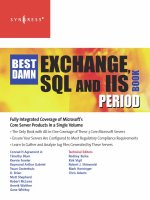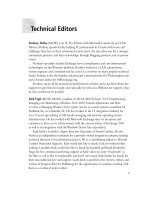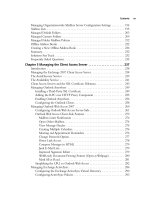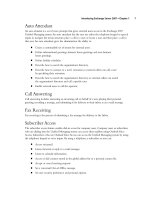Exxhange SQL And IIS- P40 docx
Bạn đang xem bản rút gọn của tài liệu. Xem và tải ngay bản đầy đủ của tài liệu tại đây (418.22 KB, 5 trang )
Managing the Exchange 2007 Mailbox Server Role • Chapter 4 167
5. On the Completion page, click Finish to create (and, if selected in the previous screen)
mount the new mailbox database (see Figure 4.8).
Figure 4.8 The New Mailbox Database Completion Page
As shown in Figure 4.8, you can also create a new mailbox database using the New-MailboxDatabase
CMDlet. To get a list of available parameters, type Get-Help New-MailboxDatabase.
Now that we have created a new mailbox database, let’s take a look at the Properties page for
such a database. We do so by selecting the database and clicking Properties in the Action pane.
The fi rst tab is General. Here we can rename the mailbox database as well as see information
such as database copy path (only available when local continuous replication has been enabled for the
storage group containing the particular database), last full backup, and status (mounted or dismounted)
as well as the last time a modifi cation was made. In addition, you have the option of enabling Journal
Recipient, used to specify the mailbox that should receive a copy of all messages sent to and from
mailboxes in a particular mailbox database. We’ll talk much more about journaling in Chapter 6.
168 Chapter 4 • Managing the Exchange 2007 Mailbox Server Role
As is the case with Exchange Server 2003, we also have the option of specifying the maintenance
schedule, which is the time where the Exchange maintenance tasks will run. The Exchange maintenance
tasks are a series of operations that are performed to ensure logical consistency in a database.
If you’re planning to have multiple storage groups with each separate set of databases on a single
Exchange 2007 mailbox server, it’s recommended that you confi gure the maintenance schedule for
each database so that they don’t overlap. In addition, this schedule should be confi gured so that it
doesn’t confl ict with your backup schedule.
The Exchange database maintenance tasks consist of 10 operations, which are listed in Table 4.1.
Table 4.1 Exchange 2007 Database Maintenance Tasks
Tasks Description
Purge mailbox and Public Purges indices that the client creates in database tables to
Folder database indexes be used for views; those that have not been used for
a specifi ed time are cleaned up when this subtask occurs.
Tombstone maintenance Compacts the deleted message information that is used
for local and Public Folder replication.
Dumpster cleanup Cleans up any messages that have passed their deleted
item retention date on mailbox and Public Folder
databases.
Public Folder expiry Expired messages that are in Public folders and that are
older than a specifi ed time value. The setup for message
expiration is on the Age Limits tab in the public
information store container in the Microsoft Exchange
Server Administrator program.
Age folder tombstone Removes folder tombstone entries that are older than
a specifi ed time (the default is 180 days). Folder tombstone
information is used by public folder replication. The aging
prevents the folder tombstone list from growing without
limits.
Folder confl ict cleanup Cleans up any confl icts on messages that have been
modifi ed by two different users at the same time and that
have resulted in the given message being in confl ict.
Update server versions Updates the version information as necessary for any
Public Folder databases that contain a replica of a system
confi guration folder.
Secure folders cleanup Checks secure folders to ensure that no message has
a reference count of zero, indicating no folder currently
has a reference to the particular message.
Site folder check Used by Public Folder databases to ensure that no
duplicate site folders exist.
Deleted mailbox cleanup Checks Active Directory to determine whether there are
any deleted mailboxes. The information store performs
an Active Directory lookup for each user in the MDB.
Managing the Exchange 2007 Mailbox Server Role • Chapter 4 169
On the General tab (see Figure 4.9), you also have the option of confi guring the database not
to mount during startup and enable the This database can be overwritten by a restore option,
which is used when you need to restore a database from backup. Nothing has changed here
compared with Exchange Server 2003.
Figure 4.9 The General Tab on the Properties Page for a Mailbox Database
Let’s move on to the Limits tab (see Figure 4.10). As is also the case with Exchange Server 2003,
we here have the option of confi guring the storage limit for the mailboxes in the particular mailbox
database. Note that the options “Issue warning at (KB),” “Prohibit send at (KB),” and “Prohibit send
and receive at (KB)” in Exchange Server 2007 are by default set drastically higher (around 2GB) than
was the case in Exchange Server 2003. Again, this is to take advantage of the Exchange 2007 64-bit
architecture.
On this tab you also have the option of changing the warning message interval and the deletion
settings. Note that the “Keep deleted items for (days)” and “Keep Deleted mailboxes for (days)”
170 Chapter 4 • Managing the Exchange 2007 Mailbox Server Role
options have other default settings than was the case in Exchange Server 2003. The end user can now
retrieve items from the dumpster 14 days back, and any deleted mailboxes will not be purged before
approximately a month passes, meaning that the reason for restoring a database to retrieve data in
a deleted mailbox will be reduced even further.
Figure 4.10 The Limits Tab on the Properties Page for a Mailbox Database
Now it’s time to take a look at what’s hiding under the Client Settings tab. As you can see
in Figure 4.11, this is the place where you can specify the public folder database as well as the
offl ine address book (OAB) that should be the default for mailboxes in the particular mailbox
database.
Managing the Exchange 2007 Mailbox Server Role • Chapter 4 171
NOTE
The OAB is an address book that Outlook 2003 and 2007 download to the local
computer (client). With the OAB fi le held locally on the client, it doesn’t need to
have access to Active Directory to browse and look up recipients in the GAL. Outlook
2003 and 2007 also use the OAB when working in cached mode, which means that
it can take up to 24 hours before newly created mailbox-enabled recipients can be
looked up by clients working in cached mode. OAB fi les can still be distributed using
Public Folders (used by legacy clients such as Outlook 98, 2000, and 2003), but in
Exchange 2007, OAB distribution is Web based.
Figure 4.11 The Client Settings Tab on the Properties Page for
a Mailbox Database









